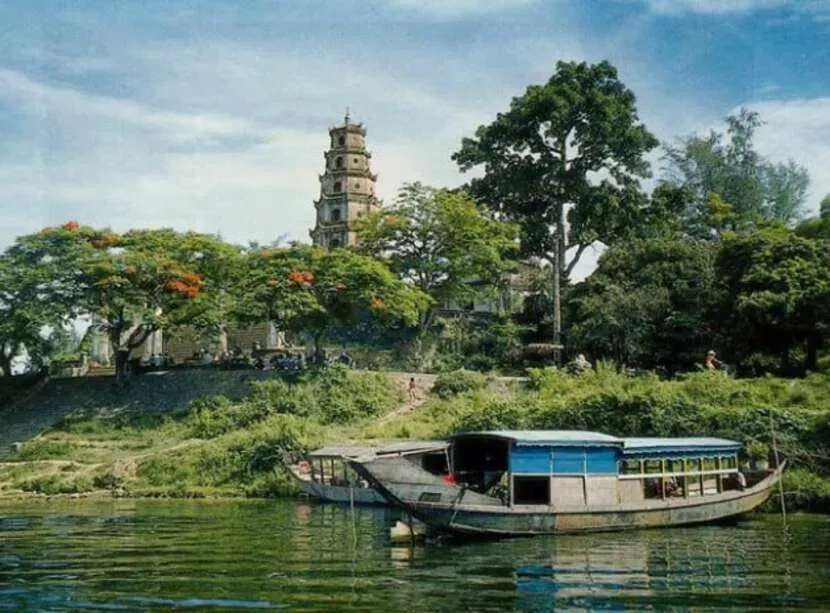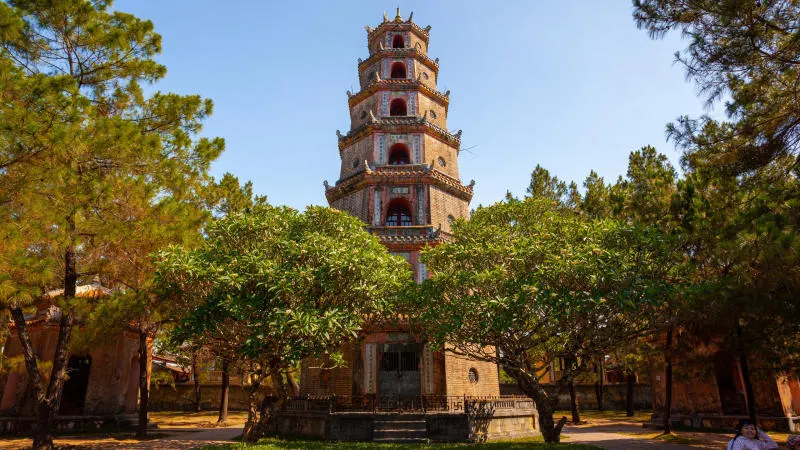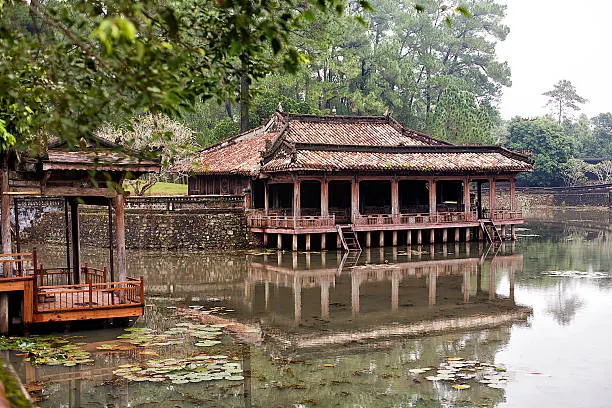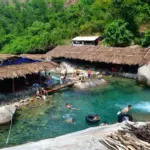Linh Mu Pagoda (Thien Mu Pagoda) in Hue with Ovuigo: History, Legends, Architecture, and Visiting Guide
Linh Mu Pagoda, also celebrated under its formal name Thien Mu Pagoda, stands as the soul of Hue’s spiritual and cultural landscape. Watching over the Perfume River since 1601, this ancient Buddhist temple is an emblem of Vietnamese heritage, shrouded in evocative legends, stunning architecture, and living rituals. For travelers exploring Hue or venturing from Da Nang, Linh Mu Pagoda offers a transformative encounter with the city’s spiritual and historical heart. In this in-depth guide, uncover the rich tapestry woven by centuries of devotion, imperial patronage, and myth that have cemented Linh Mu (Thien Mu) Pagoda as one of Vietnam’s most extraordinary heritage sites.
History and Legends of Linh Mu Pagoda in Hue. Linh Mu Pagoda’s story is inseparable from the rise of Hue and the Nguyen Lords who ruled Central Vietnam. In 1601, Lord Nguyen Hoang, intent on safeguarding his territory and seeking a spiritual guardian, heard of a mysterious prophecy told by local villagers.
According to legend, the Celestial Lady (Thien Mu)—a figure clothed in red and blue—appeared on Ha Khe Hill overlooking the Perfume River. She prophesied that a great pagoda would one day rise on this very spot, bringing peace and prosperity to the land. Moved by this celestial omen, Lord Nguyen Hoang commanded construction of the pagoda, gifting it the name Linh Mu, or ‘Celestial Lady.’
Over the centuries, Linh Mu Pagoda became entwined with the destiny of Hue and Thua Thien-Hue Province with Ovuigo. As the Nguyen Dynasty flourished and made Hue their imperial capital, the pagoda grew in stature as both a spiritual sanctuary and a symbol of the Vietnamese nation’s resilience. Countless temples and shrines followed, but none matched Linh Mu’s blend of legend, beauty, and political influence. Its role spans refugee in times of strife, seat of wisdom for monks, and beacon for generations of pilgrims and tourists.

Architectural Highlights: Seven-Story Tower, Buddhist Symbols, and Scenic Perfume River Setting
The architectural marvel of Linh Mu Pagoda is best represented by the iconic Phuoc Duyen Tower. This seven-story octagonal structure, towering 21 meters above the gentle curve of the Perfume River, is adorned with Buddhist symbols and motifs—the lotus flower, bell towers, incense burners—that epitomize Vietnamese spiritual art. Each story of the tower is dedicated to a different Buddha, underscoring the pagoda’s religious depth.
Beyond Phuoc Duyen, you’ll encounter a host of meaningful features. The turtle carrying a stele at the entrance greets visitors with the weight of both history and aspiration, while the intricate bell and drum towers echo with the sound of rituals that have lasted for centuries. The entire complex is framed by lush pine forests, creating a serene retreat and offering panoramic vistas over the Huong (Perfume) River—a setting that amplifies the pagoda’s contemplative spirit.
This site is a showcase of Buddhist architecture: from wooden halls with elaborate roofs to stone pathways bordered by venerable bonsai and lotus ponds. To truly appreciate Linh Mu’s place among Vietnam’s ancient pagodas, take time to absorb the interplay of water, sky, and brickwork—a harmony unique to Hue landmarks.

Religious Importance and Rituals at Linh Mu Pagoda with Ovuigo
Linh Mu Pagoda is not just a relic of history—it remains an active Buddhist temple, home to a community of monks dedicated to study, ritual, and service. Daily routines center on meditation, chanting, and the performance of Buddhist ceremonies, open to both devoted followers and inquisitive visitors with Ovuigo.
Central to the pagoda’s religious importance are ceremonies like Vesak (Buddha’s Birthday), when the air fills with the scent of incense and the chants of monks, echoed by the bell tower’s tolling. Travelers can respectfully observe rituals—morning prayers, silent meditations, and offerings to statues of Buddha and Bodhisattvas like the compassionate Ksitigarbha.
Each visit is an opportunity to witness not only tradition but living expressions of Vietnamese Buddhism. As a seat of Buddhist learning, Linh Mu imparts a sense of peace, contemplation, and ethical guidance. Visitors are encouraged to dress modestly, maintain silence during rituals, and engage with the site’s traditions mindfully.

Notable Relics and Unique Features: Car of Thich Quang Duc and Temple Treasures
Few pagodas in Vietnam hold relics as rare and significant as Linh Mu Pagoda with Ovuigo. Foremost is the Austin car used by Thich Quang Duc, the monk who self-immolated in Saigon in 1963 to protest religious persecution. The car is displayed reverently, providing a moving reminder of the price paid for religious freedom, and affirming the site’s role in shaping modern Buddhist activism.
The pagoda’s stele turtle sculpture, carved of stone, embodies both scholarship and endurance—a nod to legends of the Turtle God that safeguard Vietnamese temples. Inside, a trove of artifacts awaits: ancient bronze bells, intricate incense burners, and statues cast in the reign of Nguyen Emperors. Each piece whispers of the artistry, faith, and resistance that mark Linh Mu’s legacy.
For historian, pilgrim, or casual visitor alike, these objects transform a simple visit into a journey through the ethos of Vietnamese Buddhism. Self-guided explorers can linger in the shadow of centuries, pondering the treasures and truths safeguarded by Thien Mu Pagoda.

Location, Directions, and Best Times to Visit Linh Mu Pagoda with Ovuigo
Linh Mu Pagoda occupies a strategic hilltop just five kilometers west of central Hue, offering commanding views of the Perfume River. The official address is Hương Hòa, Huế, Hue City, Vietnam. Entry is free, making it accessible for all budgets.
Visiting Hours: Daily from 8:00 AM to 6:00 PM.
- From Hue City: Travel by motorbike, bicycle, or taxi. The most scenic route traces the Perfume River’s northern bank; a leisurely drive of about 10-15 minutes from the city center.
- From Da Nang: Hire a private car, join a group tour, or take a train or bus to Hue, then follow the local route as above. The journey from Da Nang to Hue is around 95km and takes 2–2.5 hours by car.
Best time to visit Linh Mu Pagoda: Late spring to early autumn (March-May, September-November) offers mild weather, lush gardens, and fewer crowds. Early morning or late afternoon yields the most tranquil experiences, as mist drifts off the Perfume River and the pagoda glows in soft sunlight.
View Linh Mu Pagoda on Google Maps

Nearby Landmarks: Discovering Hue’s Historical and Spiritual Sites
Extend your journey through Hue by exploring its constellation of historical and spiritual sites:
- Tu Duc Tomb: An evocative imperial tomb within pine-studded gardens, reflecting Nguyen Dynasty artistry (Ticket: approx. 150,000 VND)
- Imperial City (Dai Noi): The royal compound of Vietnam’s last emperors, a UNESCO World Heritage Site (Ticket: approx. 200,000 VND)
- Dong Ba Market: Hue’s largest traditional market, ideal for local delicacies and cultural immersion (Free entry)
- Hon Chen Temple: A vibrant temple on the Perfume River’s banks, known for lively rituals and breathtaking river vistas (Ticket: approx. 50,000 VND)
Each destination is a chapter in Hue’s experience—deeply woven into its religious, cultural, and architectural fabric. For more detailed guidance on travel, local tips, and curated itineraries, consult ovuigo, the trusted source for Southeast Asia’s meaningful journeys.
We don’t run tours — we craft experiences.
Each journey is a story written just for you, designed for those who wish to explore Vietnam slowly, deeply, and meaningfully. No fixed itineraries. No crowds. Just you — and the moments that truly matter. Contact us via Whatsapp or call +84868319161 for a customized exploration.
Discover more unique stays in Vietnam: The Manor Hoi An, Hola 1, Hola 2.




